We recently had a new patient see us with no tooth complaints, she just needed a check up and wanted to discuss her headaches to see if we could help. During her exam, I noticed that several of her molars were severely worn down (which she already knew about) and had cracks visible. We didn’t take photos at her appointment (should have!) to show her, but she seemed comfortable with my recommendation of doing crowns on those 4 teeth to catch and contain the cracks before the teeth break. Since she decided on a second opinion for those teeth, which I fully respect, I decided this is a good opportunity to review cracks in teeth, and what (if anything) to do about them.
Tooth Cracks Don’t Show Up on X-Rays
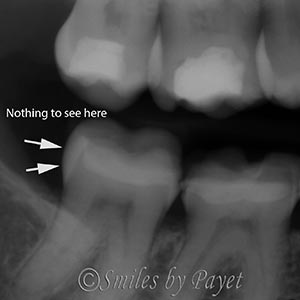 One difficulty with diagnosing cracks in teeth, is that they almost never show up on x-rays. Why, you ask? Good question! It’s because x-rays are traveling perpendicular to the cracks, and the cracks are so narrow, there’s not enough change in the tooth density for the x-rays to show it. To show up on an x-ray, a crack in a tooth would have to be so wide, you could stick a fork in it, and then you’d already know there was a problem. The x-ray shown here is from another patient we recently treated, and while you can’t see anything on the x-ray, want until you see how it looked inside the tooth (on below).
One difficulty with diagnosing cracks in teeth, is that they almost never show up on x-rays. Why, you ask? Good question! It’s because x-rays are traveling perpendicular to the cracks, and the cracks are so narrow, there’s not enough change in the tooth density for the x-rays to show it. To show up on an x-ray, a crack in a tooth would have to be so wide, you could stick a fork in it, and then you’d already know there was a problem. The x-ray shown here is from another patient we recently treated, and while you can’t see anything on the x-ray, want until you see how it looked inside the tooth (on below).
This means we have to identify cracks with our eyes, and hopefully with magnification, because teeth are pretty small to start, and cracks are even smaller. That’s one reason we use dental microscopes in our office. But how do we know which cracks are worrisome, and which aren’t? The biggest problem is that – even if we can see them with our eyes, there’s no predictable way to see how deep they go, especially if there is already a filling in the tooth, as you’ll see in the following examples.
Teeth Worn Down by Grinding Can Have Deep Cracks
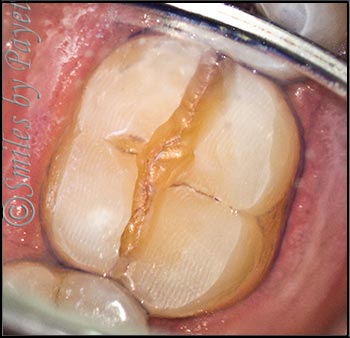 People who clench or grind their teeth are at a high risk for teeth cracking. Enamel is a crystalline matrix, which means it acts a lot like porcelain (actually, that’s one reason we use porcelain for dental crowns). The longer your grind or clench your teeth, the more you stress that matrix, and eventually a crack starts forming. You’ve probably seen a plate or glass with a crack in it that seems to stay that way for a while, right? But then one day, it suddenly breaks, sometimes for no apparent reason. Well, that’s a pretty good analogy – cracked teeth can stay that way for a long time, but when they go, they go big-time, and sometimes the tooth is a goner, like this one from 10 years ago.
People who clench or grind their teeth are at a high risk for teeth cracking. Enamel is a crystalline matrix, which means it acts a lot like porcelain (actually, that’s one reason we use porcelain for dental crowns). The longer your grind or clench your teeth, the more you stress that matrix, and eventually a crack starts forming. You’ve probably seen a plate or glass with a crack in it that seems to stay that way for a while, right? But then one day, it suddenly breaks, sometimes for no apparent reason. Well, that’s a pretty good analogy – cracked teeth can stay that way for a long time, but when they go, they go big-time, and sometimes the tooth is a goner, like this one from 10 years ago.
Three Cracked Teeth: 1 Crown and 2 Dental Fillings
So here’s our patient from yesterday, who’s teeth are a perfect example of what I see all the time (I have more than 3,000 photos of teeth with cracks, taken over the last 12+ years). As you look at the first case, which is getting a crown, you can see how worn down the tooth and old filling are. I’ve highlighted the deep crack with arrows so you can see how far it goes into the tooth – very close to the nerve!
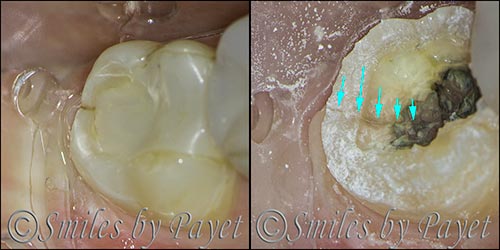
The next 2 teeth both got fillings, but the first one could easily turn into a crown, too, because that crack went way up the side of the tooth. If she has any pain on biting, she knows she’ll need a crown. I felt there was enough strong, healthy tooth structure that a bonded tooth-colored filling to try that first. BTW – see all that dark “halo” around the old filling? That was a lot of decay from bacteria that worked their way around the filling. That’s part of the problem, too: while cracks look small to us, to bacteria they’re like a 4-lane highway. When I see a “double-crack” on the side of a tooth, I pretty much know there’s a cavity, too, just like here.
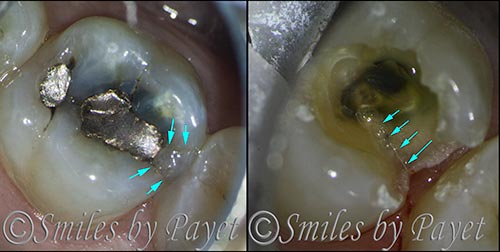
The last tooth (right next to this last one) had a much smaller crack that didn’t go nearly as deep into the tooth. This tooth will do just fine with a bonded filling.
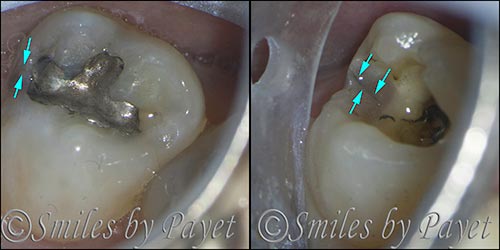
And just to show that front teeth can crack, too, although this was on a different patient.
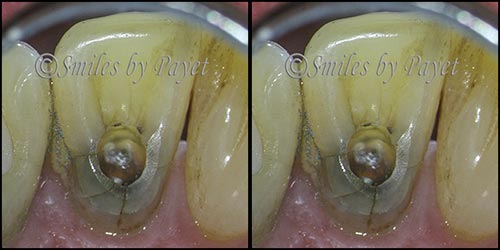
Wear a Nightguard to Prevent More Cracks
Certainly we always stress prevention over fixing things, so if you’ve been told you have cracks in your teeth, you should seriously consider a nightguard to take the stress off your teeth at night. I know that many people don’t believe they grind their teeth at night, but when you’re sound asleep, how would you know, right? Some people make noise, some don’t; some have sore jaws, others don’t – it varies a lot. But the simple act of wearing a nightguard will decrease the stress on your teeth and fillings, so they’ll all last longer with fewer problems. And look……..if your dentist tries to tell you how to save money, why wouldn’t you listen? LOL I promise, I make a lot LESS money on a nightguard than on fillings and crowns.
If you’re worried about cracked teeth,
Request an Appointment Online or call us at 704-364-7069.
We’ll look forward to meeting you soon!






